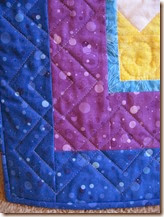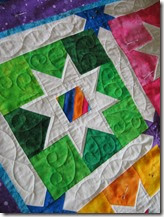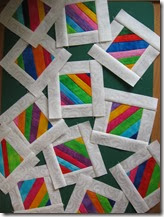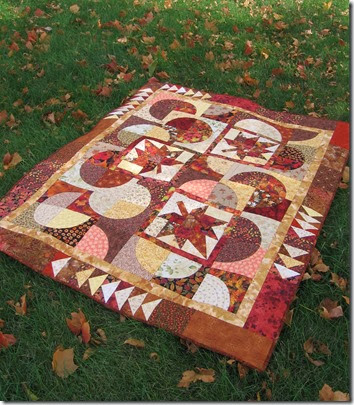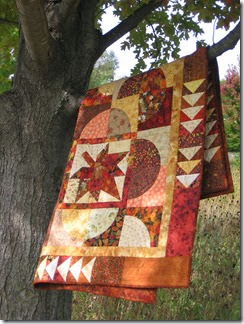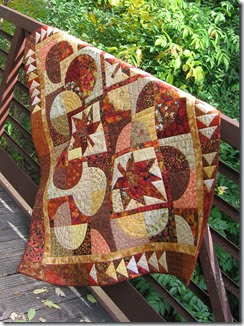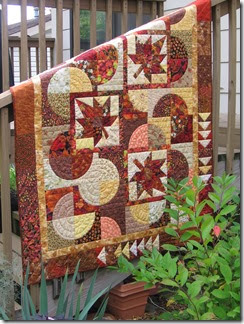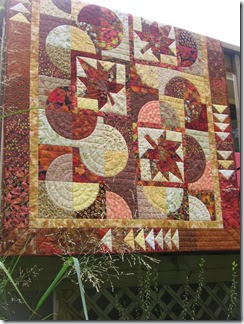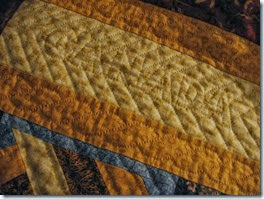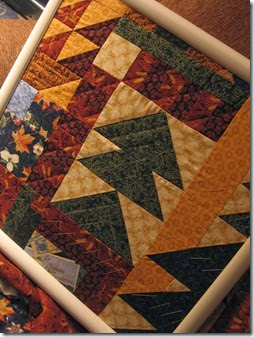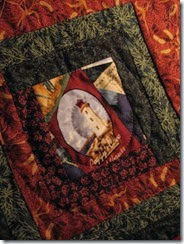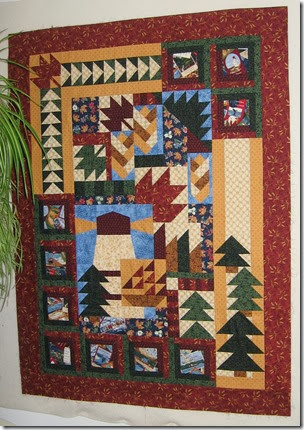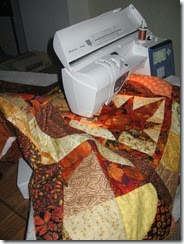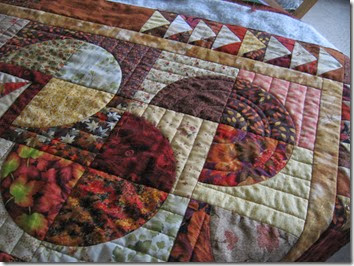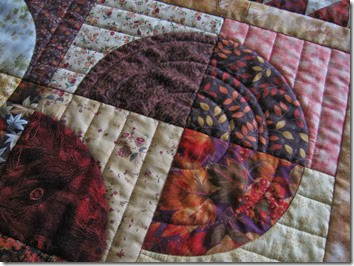The idea of reducing my UFO count to zero is intriguing so I’m going to give it a shot. After all, the list is currently only two quilt tops long. There will never be a better opportunity!
With that in mind I got around to basting my Quilter’s Scrapbook quilt over the weekend. This was the 3rd or 4th quilt I basted using the frame and I think I have finally figured out the easiest way to load the quilt. I took pictures this time to refresh my memory next time.
Here are all the parts and tools:
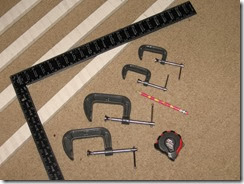
- 4 straight 8 foot long 1x2 boards wrapped in muslin (I cut two of mine down to 7’ to accommodate the low ceilings in my quilting space)
- 4 C-clamps (they don’t have to be two different sizes, but mine came in a package like this)
- 1 tape measure
- 1 pencil
- 1 carpenter’s square
- a large supply of medium or large size safety pins (oops, didn’t get them in the picture!)
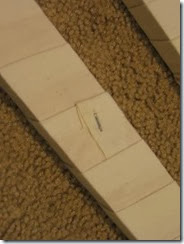
Here’s a close-up of the wrapped boards. 3” wide strips of muslin are folded in half lengthwise. One end of the strip is stapled to one end of the board. The strip is wrapped around the board in a spiral so the raw edges are covered up by the folded edge The strip is secured at the other end with another staple. I did this last year and forget how many strips I needed to cover the whole board.
The midpoint of each board is marked.
Setting up the frame
Figure out the minimum size the backing needs to be. I like to have 3” or more extending on all sides of the quilt, so for my 59” x 73” quilt the backing needed to be at least 65” x 79”.

I used these measurements to mark my boards. I’ll show the top board as an example. That is the board the top edge of the backing (65”) was attached to eventually.
Half of 65” is 32.5”. I lined up that measurement on the measuring tape with the midpoint mark on the board, as pointed out by the pencil.

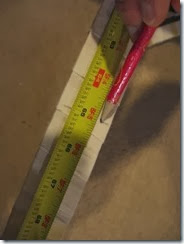
I then marked the board at 0” and 65” with the 32.5” mark still lined up in the middle of the board.
I repeated this for the bottom board and again (using the 79” side measurements) for the two side boards.
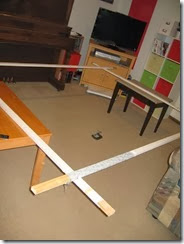
I balanced the top and bottom boards on two small tables (chairs or sawhorses would work as well) then placed the side boards across them to form the frame.

I used the length markings I made earlier to determine where to cross the boards to make the frame the correct size. Note that the marked lengths are the outside dimensions of the frame.
Using the carpenter’s square I made sure each corner was square as I clamped the boards together with a C-clamp at each corner.

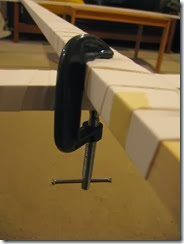
Loading the quilt
My brain was properly engaged by this point so I remembered to load the quilt back with the wrong side of the fabric facing up. (I mention this important detail because I did mess this up once in the past. Fortunately I noticed before adding the rest of the quilt layers!)
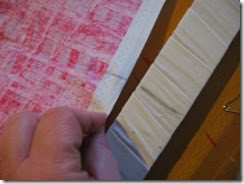
To line the back up properly in the frame I marked the middle of the top edge of the backing and matched this point up with the midpoint mark on the frames’ top board.
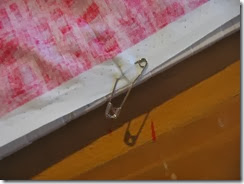
Using a safety pin I pinned the midpoint of the backing’s edge to the muslin covering the board, keeping the center marks matched up. I used a curved quilter’s safety pin but a regular safety pin works too.
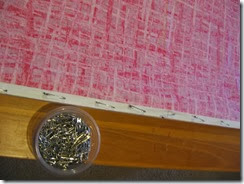
I pinned the rest of the top edge of the backing to the board in the same way.
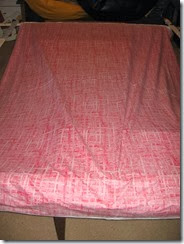
I pulled the backing fabric across the frame to the other end of the frame. You’ll notice my backing is actually longer than the frame. That’s OK. I didn’t actually cut the backing to the minimum size I needed. I just used those measurements to help me build a nice square frame. I could have cut the extra off first, but I don’t enjoy measuring lengths that are longer than my rotary cutting ruler, and letting the extra fabric hang over the edge of the frame is not a problem here, so I left it for now.
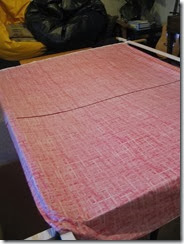
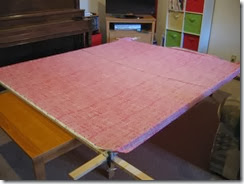
I pulled the fabric moderately taut and again matched the center of the fabric with the midpoint of the frame board, pinning the fabric to the board’s muslin wrapping. I pinned the rest of that side as well, pulling the fabric taut . Next I draped the sides of the backing over the sides of the frame and pinned them, starting near the ends and working towards the midpoint of the sides, tugging gently to draw the fabric taut across the center of the frame as I pinned, but not distorting the back.
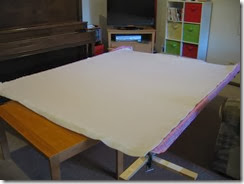
Next, I smoothed the batting over the backing…
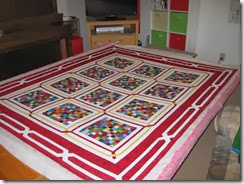
…and the quilt top over the batting.
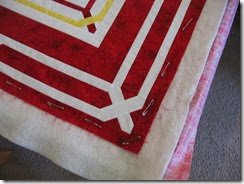
I pinned the layers of the quilt together at 4 to 5 inch intervals all around the edges of the quilt and in 5 or 6 places in the center.
Here comes the part I like best. There was no need to bend over or crawl over the quilt to pin-baste the rest. I just tipped the frame on its side and leaned it against a wall (well, in this case against the shelves I have lining the wall). It was out of the way and secure enough to leave out so I could baste standing up or sitting in a low chair in small bits of time now and then over the weekend.

I basted this one with safety pins about 4 or 5 inches apart. My rule of thumb is that, once I have finished basting, if I lay my hand on the quilt sandwich I should be touching at least one safety pin , no matter which part of the quilt I am touching. This frame also works for thread basting, which I prefer if I am going to hand quilt.
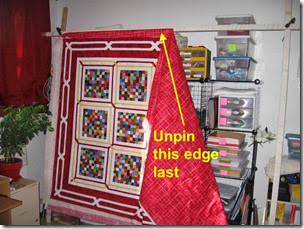
To remove the basted quilt from the frame I unpin the three lowest sides first. I save the top for last. By the time half the quilt is detached from the frame, I can throw the quilt over my shoulder to take the weight off the safety pins as I remove the last ones.
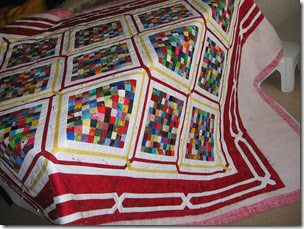
Voilà! One basted quilt ready for quilting. I am hoping that should go fairly quickly as I am not planning any elaborate quilting. I’m off to move the sewing machine into position!

